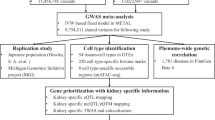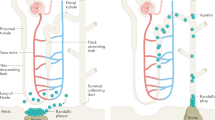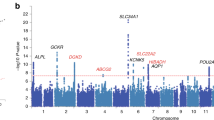Abstract
Kidney stone disease is a common condition. To search for sequence variants conferring risk of kidney stones, we conducted a genome-wide association study in 3,773 cases and 42,510 controls from Iceland and The Netherlands. We discovered common, synonymous variants in the CLDN14 gene that associate with kidney stones (OR = 1.25 and P = 4.0 × 10−12 for rs219780[C]). Approximately 62% of the general population is homozygous for rs219780[C] and is estimated to have 1.64 times greater risk of developing the disease compared to noncarriers. The CLDN14 gene is expressed in the kidney and regulates paracellular permeability at epithelial tight junctions. The same variants were also found to associate with reduced bone mineral density at the hip (P = 0.00039) and spine (P = 0.0077).
This is a preview of subscription content, access via your institution
Access options
Subscribe to this journal
Receive 12 print issues and online access
$209.00 per year
only $17.42 per issue
Buy this article
- Purchase on Springer Link
- Instant access to full article PDF
Prices may be subject to local taxes which are calculated during checkout

Similar content being viewed by others
References
Coe, F.L., Evan, A. & Worcester, E. Kidney stone disease. J. Clin. Invest. 115, 2598–2608 (2005).
Trinchieri, A. et al. A prospective study of recurrence rate and risk factors for recurrence after a first renal stone. J. Urol. 162, 27–30 (1999).
Moe, O.W. Kidney stones: pathophysiology and medical management. Lancet 367, 333–344 (2006).
Hess, B., Hasler-Strub, U., Ackermann, D. & Jaeger, P. Metabolic evaluation of patients with recurrent idiopathic calcium nephrolithiasis. Nephrol. Dial. Transplant. 12, 1362–1368 (1997).
Tefekli, A. et al. Metabolic risk factors in pediatric and adult calcium oxalate urinary stone formers: is there any difference? Urol. Int. 70, 273–277 (2003).
Levy, F.L., Adams-Huet, B. & Pak, C.Y. Ambulatory evaluation of nephrolithiasis: an update of a 1980 protocol. Am. J. Med. 98, 50–59 (1995).
Edvardsson, V., Elidottir, H., Indridason, O.S. & Palsson, R. High incidence of kidney stones in Icelandic children. Pediatr. Nephrol. 20, 940–944 (2005).
Stechman, M.J., Loh, N.Y. & Thakker, R.V. Genetics of hypercalciuric nephrolithiasis: renal stone disease. Ann. NY Acad. Sci. 1116, 461–484 (2007).
Polito, C., La Manna, A., Nappi, B., Villani, J. & Di Toro, R. Idiopathic hypercalciuria and hyperuricosuria: family prevalence of nephrolithiasis. Pediatr. Nephrol. 14, 1102–1104 (2000).
Goldfarb, D.S., Fischer, M.E., Keich, Y. & Goldberg, J. A twin study of genetic and dietary influences on nephrolithiasis: a report from the Vietnam Era Twin (VET) Registry. Kidney Int. 67, 1053–1061 (2005).
Angelow, S., Ahlstrom, R. & Yu, A.S. Biology of claudins. Am. J. Physiol. Renal Physiol. 295, F867–F876 (2008).
Wilcox, E.R. et al. Mutations in the gene encoding tight junction claudin-14 cause autosomal recessive deafness DFNB29. Cell 104, 165–172 (2001).
Duan, J. et al. Synonymous mutations in the human dopamine receptor D2 (DRD2) affect mRNA stability and synthesis of the receptor. Hum. Mol. Genet. 12, 205–216 (2003).
Wang, D., Johnson, A.D., Papp, A.C., Kroetz, D.L. & Sadee, W. Multidrug resistance polypeptide 1 (MDR1, ABCB1) variant 3435C>T affects mRNA stability. Pharmacogenet. Genomics 15, 693–704 (2005).
Zhang, H. et al. Association between two mu-opioid receptor gene (OPRM1) haplotype blocks and drug or alcohol dependence. Hum. Mol. Genet. 15, 807–819 (2006).
Emilsson, V. et al. Genetics of gene expression and its effect on disease. Nature 452, 423–428 (2008).
Asplin, J.R. et al. Bone mineral density and urine calcium excretion among subjects with and without nephrolithiasis. Kidney Int. 63, 662–669 (2003).
Kanis, J.A., Melton, L.J. III, Christiansen, C., Johnston, C.C. & Khaltaev, N. The diagnosis of osteoporosis. J. Bone Miner. Res. 9, 1137–1141 (1994).
Gudmundsdottir, S.L., Indridason, O.S., Franzson, L. & Sigurdsson, G. Age-related decline in bone mass measured by dual-energy X-ray absorptiometry and quantitative ultrasound in a population-based sample of both sexes: identification of useful ultrasound thresholds for osteoporosis screening. J. Clin. Densitom. 8, 80–86 (2005).
Styrkarsdottir, U. et al. Multiple genetic loci for bone mineral density and fractures. N. Engl. J. Med. 358, 2355–2365 (2008).
Richards, J.B. et al. Bone mineral density, osteoporosis, and osteoporotic fractures: a genome-wide association study. Lancet 371, 1505–1512 (2008).
Styrkarsdottir, U. et al. New sequence variants associated with bone mineral density. Nat. Genet. 41, 15–17 (2009).
Timpson, N.J. et al. Common variants in the region around Osterix are associated with bone mineral density and growth in childhood. Hum. Mol. Genet. 18, 1510–1517 (2009).
Uitterlinden, A.G. et al. Polymorphisms in the sclerosteosis/van Buchem disease gene (SOST) region are associated with bone-mineral density in elderly whites. Am. J. Hum. Genet. 75, 1032–1045 (2004).
Sims, A.M. et al. Genetic analyses in a sample of individuals with high or low BMD shows association with multiple Wnt pathway genes. J. Bone Miner. Res. 23, 499–506 (2008).
Krause, G. et al. Structure and function of claudins. Biochim. Biophys. Acta 1778, 631–645 (2008).
Simon, D.B. et al. Paracellin-1, a renal tight junction protein required for paracellular Mg2+ resorption. Science 285, 103–106 (1999).
Konrad, M. et al. Mutations in the tight-junction gene claudin 19 (CLDN19) are associated with renal magnesium wasting, renal failure, and severe ocular involvement. Am. J. Hum. Genet. 79, 949–957 (2006).
Elkouby-Naor, L., Abassi, Z., Lagziel, A., Gow, A. & Ben-Yosef, T. Double gene deletion reveals lack of cooperation between claudin 11 and claudin 14 tight junction proteins. Cell Tissue Res. 333, 427–438 (2008).
Ben-Yosef, T. et al. Claudin 14 knockout mice, a model for autosomal recessive deafness DFNB29, are deaf due to cochlear hair cell degeneration. Hum. Mol. Genet. 12, 2049–2061 (2003).
Angelow, S., Kim, K.J. & Yu, A.S. Claudin-8 modulates paracellular permeability to acidic and basic ions in MDCK II cells. J. Physiol. (Lond.) 571, 15–26 (2006).
Lemann, J. Jr, Bushinsky, D.A. & Hamm, L.L. Bone buffering of acid and base in humans. Am. J. Physiol. Renal Physiol. 285, F811–F832 (2003).
Frazer, K.A. et al. A second generation human haplotype map of over 3.1 million SNPs. Nature 449, 851–861 (2007).
Wetzels, J.F., Kiemeney, L.A., Swinkels, D.W., Willems, H.L. & den Heijer, M. Age- and gender-specific reference values of estimated GFR in Caucasians: the Nijmegen Biomedical Study. Kidney Int. 72, 632–637 (2007).
Bagger, Y.Z. et al. Links between cardiovascular disease and osteoporosis in postmenopausal women: serum lipids or atherosclerosis per se? Osteoporos. Int. 18, 505–512 (2007).
Kutyavin, I.V. et al. A novel endonuclease IV post-PCR genotyping system. Nucleic Acids Res. 34, e128 (2006).
Gretarsdottir, S. et al. The gene encoding phosphodiesterase 4D confers risk of ischemic stroke. Nat. Genet. 35, 131–138 (2003).
Rice, J.A. Mathematical Statistics and Data Analysis (Wadsworth, Belmont, California, 1995).
Mantel, N. & Haenszel, W. Statistical aspects of the analysis of data from retrospective studies of disease. J. Natl. Cancer Inst. 22, 719–748 (1959).
Devlin, B. & Roeder, K. Genomic control for association studies. Biometrics 55, 997–1004 (1999).
Stefansson, H. et al. A common inversion under selection in Europeans. Nat. Genet. 37, 129–137 (2005).
Rozen, S. & Skaletsky, H. Primer3 on the WWW for general users and for biologist programmers. Methods Mol. Biol. 132, 365–386 (2000).
Uyguner, O. et al. Frequencies of gap- and tight-junction mutations in Turkish families with autosomal-recessive non-syndromic hearing loss. Clin. Genet. 64, 65–69 (2003).
Author information
Authors and Affiliations
Contributions
The study was designed and results interpreted by G.T., H.H., G.B.W., V.E., O.S.I., R.P., M.B., K.K., U.S., T.R., U.T. and K.S. Statistical analysis was carried out by G.T., D.F.G., P.S., B.V.H. and A.K. V.E., O.S.I., R.P., G.S. and L.F. collected the Icelandic data. F.d.V., F.C.H.d'A., M.d.H. and L.A.K. collected the Dutch data. C.C. and P.A. collected the Danish data. Authors H.H., G.T., G.B.W., U.T. and K.S. wrote the first draft of the paper. All authors contributed to the final version.
Corresponding authors
Ethics declarations
Competing interests
For the authors who are affiliated with deCODE genetics, we declare the following competing financial interests statement: some of the authors employed by deCODE genetics own stock or stock options in the company.
Supplementary information
Supplementary Text and Figures
Supplementary Figure 1 and Supplementary Tables 1–8 (PDF 252 kb)
Rights and permissions
About this article
Cite this article
Thorleifsson, G., Holm, H., Edvardsson, V. et al. Sequence variants in the CLDN14 gene associate with kidney stones and bone mineral density. Nat Genet 41, 926–930 (2009). https://doi.org/10.1038/ng.404
Received:
Accepted:
Published:
Issue Date:
DOI: https://doi.org/10.1038/ng.404
This article is cited by
-
Integrative genome-wide analyses identify novel loci associated with kidney stones and provide insights into its genetic architecture
Nature Communications (2023)
-
The role of claudins in homeostasis
Nature Reviews Nephrology (2023)
-
Nephrocalcinosis in a 3-year-old child with hypocalcemia: Answers
Pediatric Nephrology (2023)
-
Association of functional genetic variants in TFF1 and nephrolithiasis risk in a Chinese population
BMC Urology (2022)
-
The genetics of kidney stone disease and nephrocalcinosis
Nature Reviews Nephrology (2022)



